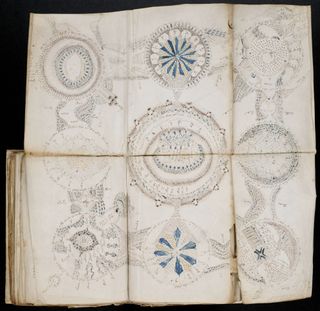Mysterious Voynich Manuscript Wasn't a Hoax, Study Suggests

The unreadable Voynich manuscript has eluded linguists and cryptographers since it was discovered by an antique book dealer in 1912.
Carbon-dated to the early 15th century, the book is written in an unknown language that has never been found anywhere else and it is full of equally puzzling drawings; besides depictions of the Zodiac signs, none of the illustrations are immediately recognizable as symbols or objects from the real world (much to the excitement of ancient alien conspiracy theorists).
The text's nonsensical nature has led some to dismiss the Voynich manuscript as a Renaissance-era hoax. But researchers who revisited the book say the words in its folios are organized with the telltale characteristics of a real language.
Marcelo Montemurro, a physicist at the University of Manchester, and his colleague Damián Zanette didn't exactly crack the Voynich code in their recent study published in the journal PLOS One. They did however find that "Voynichese" statistically adheres to linguistic rules.
Mainly, Montemurro and Zanette say the manuscript follows Zipf's law, which holds that the most frequently occurring word in natural languages will appear about twice as much as the second most common word and three times as much as the third most common word and so on. Random symbolic sequences don't show the same pattern as strongly, the researchers say.
"While the mystery of origins and meaning of the text still remain to be solved, the accumulated evidence about organization at different levels, limits severely the scope of the hoax hypothesis and suggests the presence of a genuine linguistic structure," Montemurro and Zanette concluded.
Some academics brushed off the findings, saying they're still convinced the manuscript is simply a hoax, not a lost language or an undecipherable code.
Sign up for the Live Science daily newsletter now
Get the world’s most fascinating discoveries delivered straight to your inbox.
"It's been accepted for decades that the statistical properties of Voynichese are similar, but not identical, to those of real languages," Gordon Rugg, a researcher from Keele University, told the BBC. "I don't think there's much chance that the Voynich manuscript is simply an unidentified language, because there are too many features in its text that are very different from anything found in any real language."
Rugg added that there are features that in the text that are inconsistent with most secret codes, such as the separation of words, which would in theory make it easier to crack.
Follow Megan Gannon on Twitterand Google+.Follow us @livescience, Facebook& Google+. Original article on LiveScience.com.
